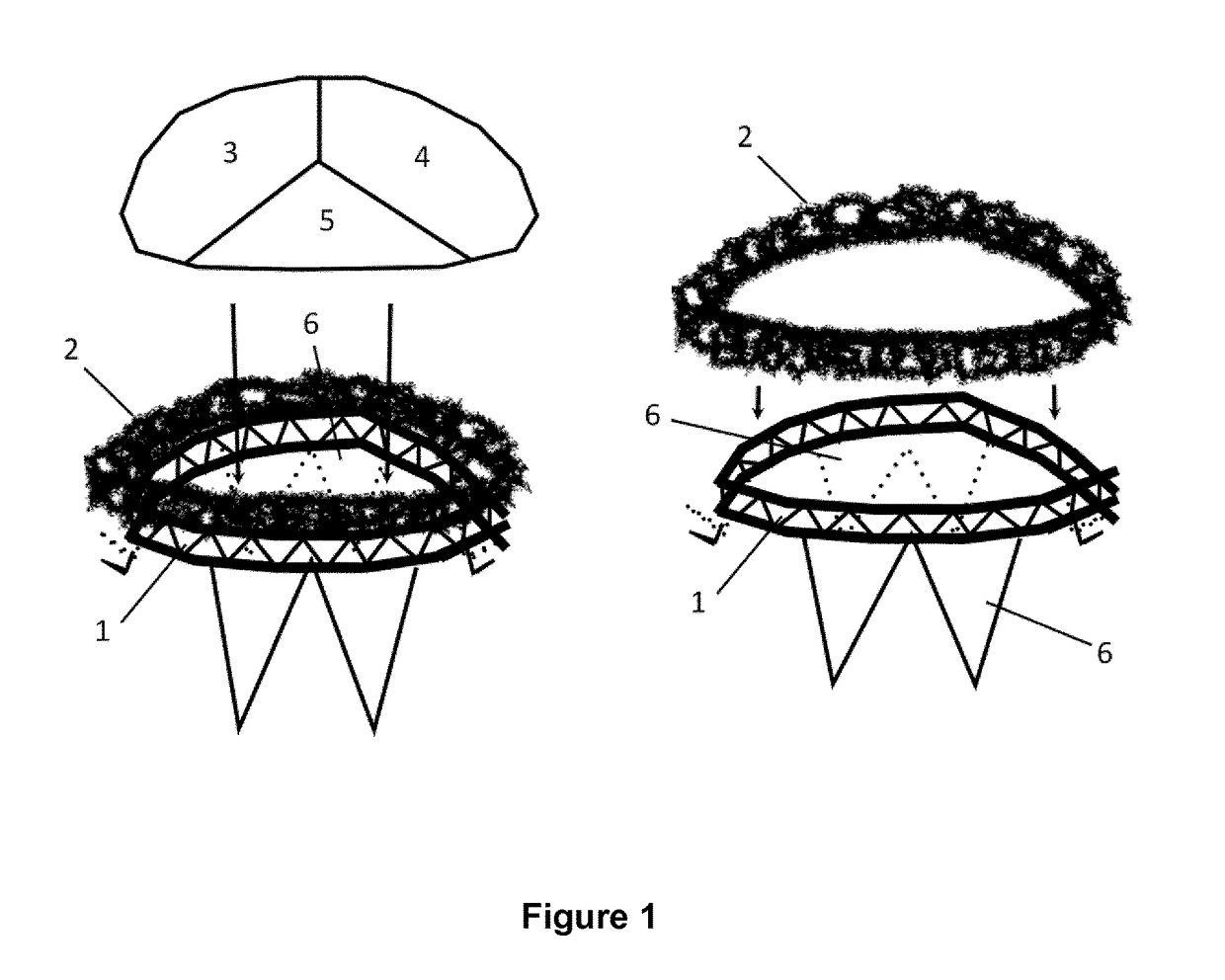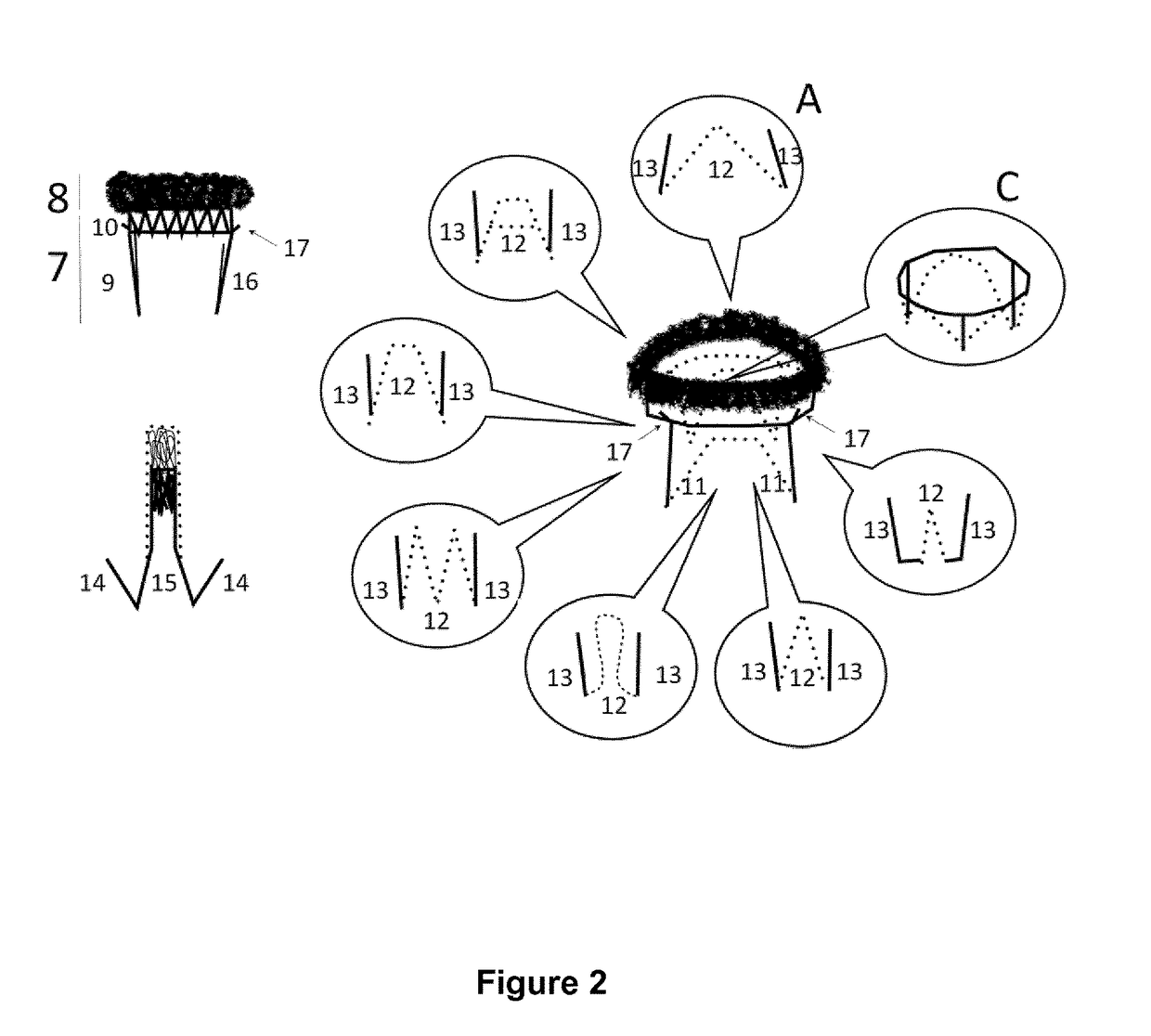Transcatheter prosthetic heart valve and delivery system
a transcatheter prosthetic and delivery system technology, applied in the field of cardiovascular treatment, can solve the problems of unacceptably high, difficult and problematic development of a device for percutaneous replacement of the mitral valve, and achieve the effect of safe removal
- Summary
- Abstract
- Description
- Claims
- Application Information
AI Technical Summary
Benefits of technology
Problems solved by technology
Method used
Image
Examples
embodiment 1
[0032]FIG. 1 shows a first embodiment of a prosthetic mitral valve according to the present invention comprising a stent (1) and a wire mesh (2) surrounding the stent at the atrial end and forming a body around the stent (2) which extends beyond the atrial end. The stent comprises internally three valve leaflets (3,4,5). Furthermore, the stent forms at its ventricular end a pair of capturing elements (6) which capture the native leaflets thus providing positioning guidance and anchoring / retention.
embodiment 2
[0033]The endoprosthesis (FIG. 2) comprises of a plurality of leaflets, which consist of a natural and / or synthetic material and are being able to switch between their open and close position in response to the blood flow through the heart. The leaflets are attached into a collapsible wire valve frame that includes a stent (7) and a wire mesh (8). The frame has a body that defines a lumen to its inside. The exterior portion of the frame has features that serve for its conformation and stabilization / anchoring in the anatomic structures it contacts. When the endoprosthesis apparatus is expanded within the intended failing native heart valve it replaces it and resumes its function. The frame of the endoprosthesis includes a stent and a wire mesh. All these are also described in the embodiment 1.
[0034]The stent part of the endoprosthesis includes a crown (9), and a ring (10). The crown includes capturing elements for each of the native valve leaflets (11). Each such element has an exter...
embodiment 3
[0047]Another version (FIG. 4A) of the described in the embodiment 2 endoprosthesis can be deployed in the opposite way, starting from the atrial side (FIG. 4B, 4C, 4D). First, the wire mesh is gradually released within the left atrium (FIG. 4B, 4C). The valve then is pulled downward till the wire mesh seats firmly at the floor of the atrium. Then the stent ring (18) is released followed by its crown (19) that contains a plurality of anchoring structures (hooks, barbs, spikes, indentations or similar) (20) extending into the ventricular side of the annulus. Two of them may be seated and capture the fibrous trigones on both sides of the anterior leaflet and hold this leaflet wide-open. Another component of the crown may extend in the middle part of the posterior leaflet (21). This is longer and therefore the last to be completely released from the delivery system. Its final part folds completely backwards (22) towards the ventricular side of the annulus to capture the posterior leafl...
PUM
 Login to View More
Login to View More Abstract
Description
Claims
Application Information
 Login to View More
Login to View More - R&D
- Intellectual Property
- Life Sciences
- Materials
- Tech Scout
- Unparalleled Data Quality
- Higher Quality Content
- 60% Fewer Hallucinations
Browse by: Latest US Patents, China's latest patents, Technical Efficacy Thesaurus, Application Domain, Technology Topic, Popular Technical Reports.
© 2025 PatSnap. All rights reserved.Legal|Privacy policy|Modern Slavery Act Transparency Statement|Sitemap|About US| Contact US: help@patsnap.com



